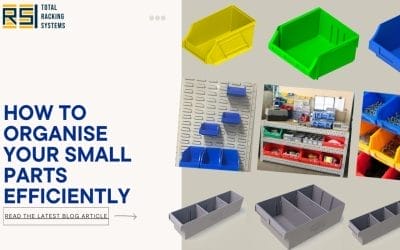Table of contents
A well-organised warehouse is key for smooth operations of storage and distribution activities. Lacking proper warehouse organisation can lead to chaos, making it hard to find items and causing safety risks.
Mastering warehouse organisation may seem daunting, but it is crucial for using space efficiently and enhancing operational efficiency. With lots of products moving in and out, it’s easy to lose rack and waste space.
Here are 5 essential strategies to enhance your warehouse organisation and ensure smooth operations in 2024:
1. Focus on Fast-Moving Items
Some products move faster than others. Prioritising the organisation of fast-moving items near packing and shipping areas. This makes it quicker to access and speeds up order fulfilment. Effective warehouse organisation in this area also helps in avoiding stock shortages.
2. Choose the Best Storage Solutions
Selecting suitable storage solutions is a cornerstone of effective warehouse organisation. Various storage systems, such as racks optimising deep storage or utilising overhead space, are pivotal. For perishable items or those with expiration dates, systems that enforce a first-in, first-out approach are essential, underscoring the importance of warehouse organisation in managing inventory efficiently.
Different types of goods and operational workflows can benefit from specific racking solutions. Here’s a closer look at some of the storage options available for improved warehouse organisation:
- Selective Pallet Racking: This is the most common type of warehouse racking and for good reason. It provides easy access to every pallet, making it ideal for a wide variety of goods, especially if you have a large assortment of SKUs. Its adaptability to any pallet size and weight makes it a versatile choice for many warehouses. Selective racking is essential for warehouse organisation that prioritises accessibility.
- Double-Deep Racking: Double-deep racks are similar to selective racks but store pallets two deep, reducing the aisle space needed. This setup increases storage density, making it a good option for warehouses with many of the same products. However, it requires a special forklift with a telescopic reach. Read our article about the difference between selective and double deep racking
- Push-Back Racking: Designed for high-density storage, push-back racking allows pallets to be stored up to six deep on either side of an aisle. As a pallet is withdrawn, the one behind it automatically slides forward, making it easier to access the next pallet. This system is great for storing bulk products and reduces the time needed to pick and restock items.
- Pallet Flow Racking: For items with expiration dates or those that need to be rotated frequently, pallet flow racking is ideal. It works on a first-in, first-out (FIFO) basis, with goods loaded at the higher end and removed at the lower end. This system is perfect for perishables, this system exemplifies the principle of efficient warehouse organisation by ensuring older stock is utilised first.
- Drive-In/Drive-Thru Racking: These systems allow forklifts to drive directly into the rack to load or unload pallets, which are stored several deep. Drive-in racking is designed for last-in, first-out (LIFO) inventory management, while drive-thru racking supports FIFO. Both are suitable for storing large quantities of uniform products and can significantly increase space utilization.
- Cantilever Rack: For long, bulky items like lumber, pipes, or furniture, cantilever racks are the best solution. They have arms extending from a central column, providing easy access and flexible storage options. This type of racking is ideal for items that don’t fit well on pallets or need to be accessed quickly without moving other goods.
You can choose the warehouse storage system that best fits your needs by carefully considering the types of products you store, their sizes, turnover rates, and access requirements. Implementing the right storage solution is a demonstration of strategic warehouse organisation, optimising your storage space and streamlining your operations, making your warehouse more efficient and responsive to your business needs.
3. Implement Lean Inventory Management
Using lean inventory means you keep just enough stock and not too much. This way, you can free up space and focus on what sells. Keeping an eye on sales trends helps you adjust what you have on hand so you’re not stuck with items that don’t move quickly.
4. Use Vertical Space
Going up, not out, can give you a lot more storage space without needing more floor space. High shelves and platforms can help you make the most of the height in your warehouse, giving you more room to store items. Read our article on the benefits of vertical storage for your warehouse.
5. Stay Organised
A tidy warehouse is a more productive one. Making sure everyone follows the layout and keeps areas for specific tasks, like receiving and packing, clear can help reduce damage to products, make your team more productive, and cut down on the time it takes to find and pack items.
Conclusion
Keeping your warehouse organised is essential for working efficiently and making the most of your space. By focusing on your fastest-moving items, picking the right warehouse storage options, keeping inventory lean, making use of vertical space, and maintaining a clean and organised space, you can make sure your warehouse operates at its best. These strategies are straightforward but can make a big difference in how smoothly your warehouse runs, helping your business stay productive and profitable in 2024 and beyond.
Need more helpful tips?
For further guidance on warehouse organisation, Total Racking Systems is at your service, offering expert advice to craft the most effective warehouse solutions tailored to your needs. If you’re in Sydney, Australia, our warehouse organisation specialists are ready to assist in enhancing your layout, operations, and overall performance. Book an onsite consultation to discuss your requirements.
Next steps:
- Contact Total Racking Systems for advice on a storage system
- View our products for more information for warehouse organisation



